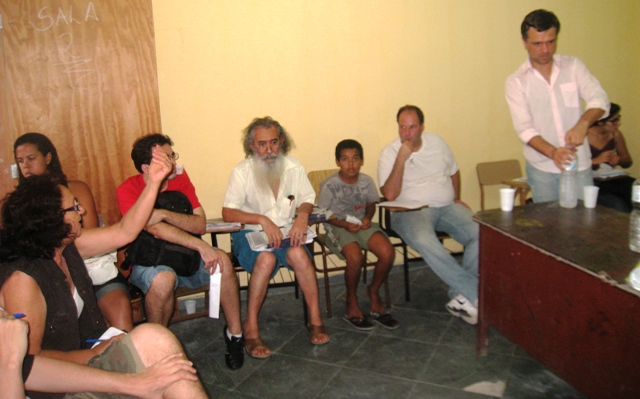
On Saturday the 26th of November the community-based organization, Rocinha sem Fronteiras (Rocinha without Borders) held their monthly meeting which always fall on the third Saturday of every month. There were roughly 20 people present. The theme of the gathering was Rocinha’s PEU or Projeto de Estruturação Urbana (Urban Structuring project). The guest speaker was Rogerio, who is finishing his PhD in urban planning at UFRJ and who in the past also worked with Toledo. Rogerio’s research is centered on Rio’s PEUs. He admitted that Rocinha is the first favela community he has even focused on that is trying to implement a PEU. Most PEUs are implemented in the ‘formal city.’ For example, there is one for Botafogo, nine in the neighborhood of Madureira and one for São Cristovão. The idea (a law actually) is relatively new, it began in 1977 and many of Rio’s neighborhoods do not yet have a PEU. Some elite neighborhoods are also trying to establish their PEUs, including Rocinha’s wealthy neighbor, São Conrado, which is trying to include in their PEU a section that would transform Estrada da Gávea, Rocinha’s main road, into a business district. Exactly what this would mean for the tens of thousands of residents who live adjacent to Estrada da Gávea is yet to be know. Rogerio mentioned that a PEU a law that in theory must be followed, unlike a Master Plan. While it was easy for the state to alter Toledo’s Master Plan it would be considerably more difficult to alter a PEU for Rocinha, which is one reason Toledo is also adamant Rocinha getting its PEU implemented.
The teleférico is increasing a divisive issue…. According to Toledo it will use up approximately 70% of the 750 million set aside for PAC 2 and it will do very little to better the quality of life for Rocinha’s residents.
It didn’t take long for the discussion of Rocinha’s PEU to turn to the hot topic of the moment, the state’s proposed teleférico (cable car) in Rocinha. The teleférico is increasing a divisive issue. Most activists in Rocinha are against the plan, but there is a small segment that is trying to convince residents that it is a good idea. These pro-teleférico residents are pretty much the same people who always gain from mega-projects in Rocinha. They are part of a highly powerful group of 30 to 40 people at the most who are constantly meddling in development projects and seeking ways to make money at the expense of Rocinha’s masses. Rocinha has long been a money making machine for people with little scruples – whether they are drug traffickers, gambling bosses, dubious NGOs, shady businesses, or corrupt politicians. For honest workers life in Rocinha and in Rio de Janeiro is very difficult, and the lure of ‘hustling’ is strong in communities like Rocinha. A few dozen of Rocinha’s residents have profited tremendously out of development projects like PAC. Literally millions were stolen and misused from PAC 1 and the teleférico, part of PAC 2, will certainly be another way corrupt ‘leaders’ will make money, because they will do their best (including coercion, intimidation and violence) to make sure that the corrupt outsiders (external politicians and corporations) make even more money here.
Rocinha has long been a money making machine for people with little scruples – whether they are drug traffickers, gambling bosses, dubious NGOs, shady businesses, or corrupt politicians.
Mundo Real is openly against the idea of building a teleférico in Rocinha. According to Toledo it will use up about 70% of the 750 million set aside for PAC 2 and it will do very little to better the quality of life for Rocinha’s residents. The Rocinha sem Fronteiras meeting was supposed to focus on Rogerio and a discussion of Rocinha’s PEU, but much like this posting the meeting was diverted by the contentious issue of the teleférico. In all fairness the teleférico is highly related to Rocinha’s PEU, and it is a part of the Urban Structuring Project that most of Rocinha’s sincere activists against.


You must be logged in to post a comment.